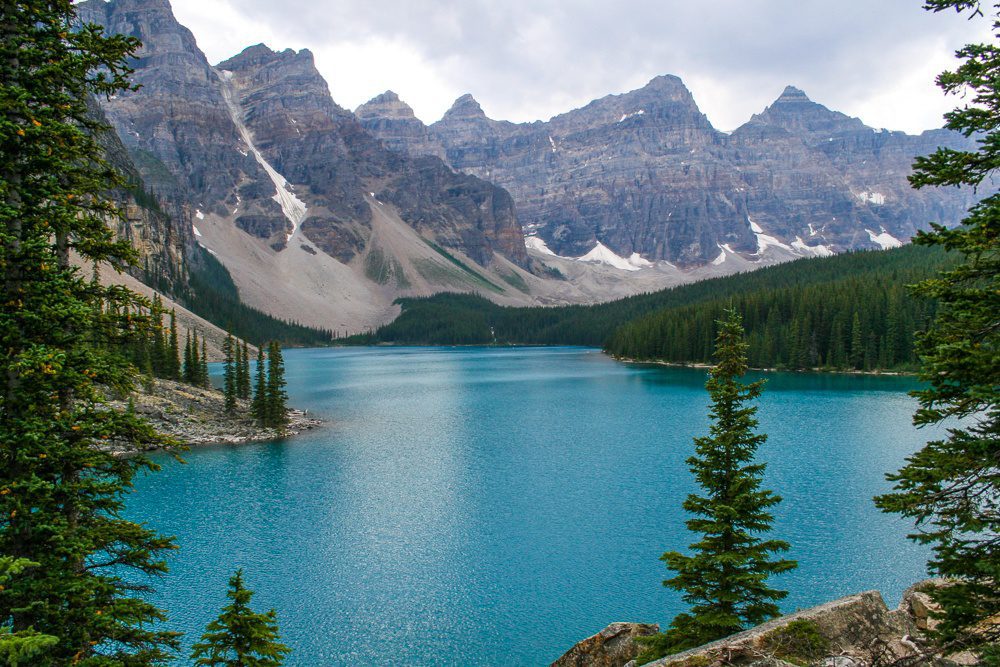Are you planning 1 week in Spain? It’s a great way to get a taste of Spanish culture, food, brilliant architecture, and stunning natural beauty, as well as learn about some of its diverse history.
With 7 days in Spain, you’ll have just enough time to fall in love with one of Europe’s most fascinating destinations so that it inspires your second trip!
I’ve been lucky enough to travel to Spain several times, each for varying lengths of time, traveling the country from north to south.
In this guide, you’ll find 6 itinerary examples and ideas about how to spend one week in Spain. Along with each Spain itinerary option, you’ll find practical information about where to start, what to see and do, how to get around, and where to stay.
Are you ready to explore spectacular Spain?
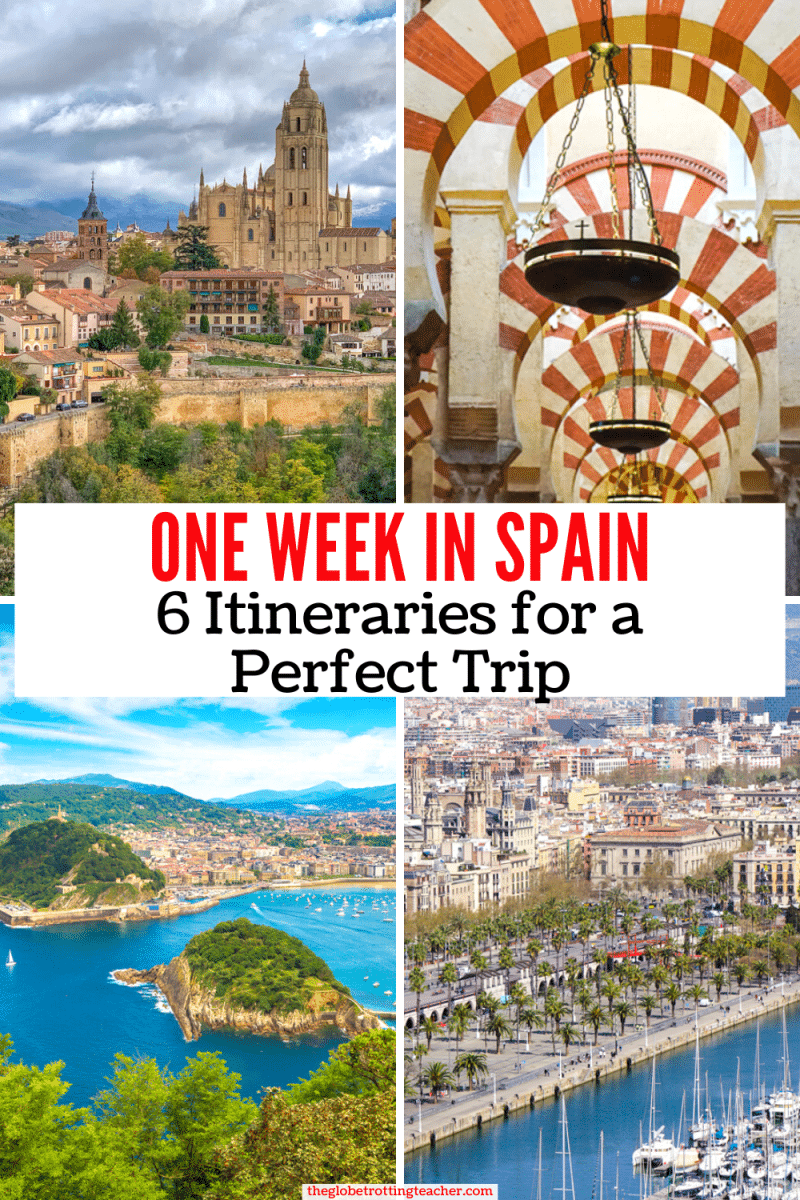
1 Week in Spain – 6 Itineraries to Plan Your Perfect Trip
Let’s start with a few quick general notes before we dive into each Spain itinerary so that you understand how to best plan all the logistics.
If your Spain itinerary includes both Madrid and Barcelona, you’ll want to fly into one city and out of the other to maximize your time. Airlines typically don’t charge extra for this type of multi-city itinerary within the same country.
If you’re flying from and back to the U.S., you’ll find direct flights between several U.S. cities and Madrid and Barcelona. If you’re itinerary ends in a city with a smaller airport like Malaga, Seville, or Bilbao, you’ll have to connect through Madrid or even another European city like Lisbon.
These Spain itineraries also make use of the country’s excellent train system. There are high-speed trains connecting many cities, including between Barcelona and Madrid and Madrid and Seville. In some cases, it’ll make the most sense to take an early evening train to your next place so that you can start the next day fresh.
Think carefully about your travel style and how much moving around you want to do. While it may seem easy to connect to different places via train, you must factor in the time it’ll take for you to drop your bags at a new hotel or accommodation and get acclimated to a new place.
None of these itineraries factor in your departure day. Most, if not all flights to Spain from North America will depart at night. This allows you to work or take care of the last details at home while still making it to your night flight to Spain.
The first days of these itineraries begin the morning you arrive and get started right away to make the most of your week in Spain.
1 Week in Spain Option #1: Madrid & Barcelona Highlights with Day Trips
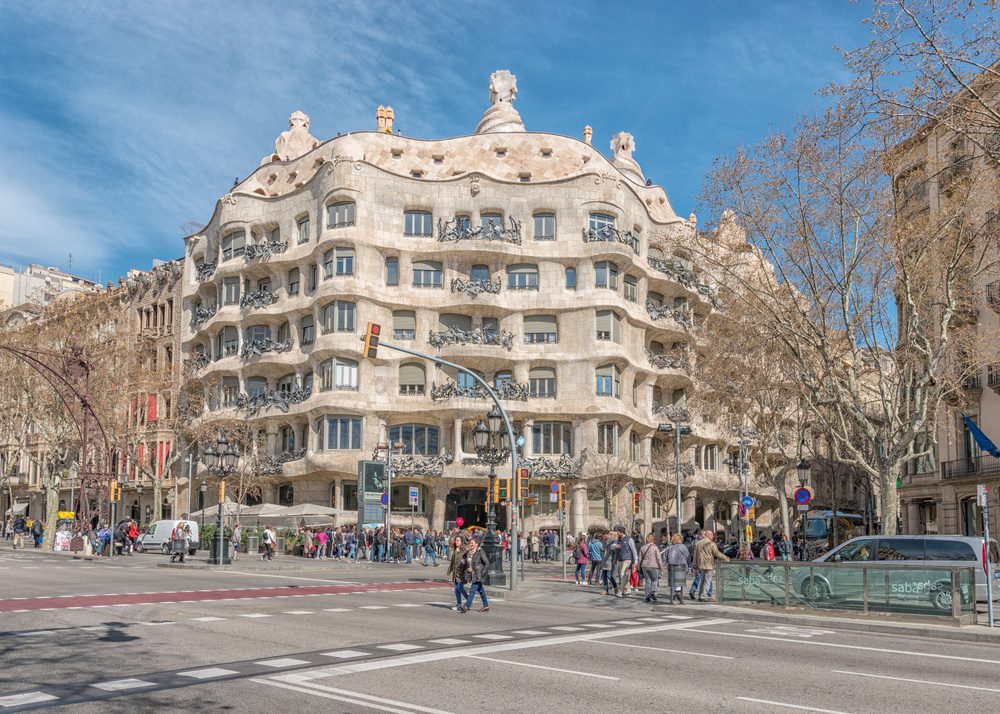
Getting Around
No rental car needed! Use Spain’s high-speed trains to get from place to place.
Where to Stay
Use Madrid and Barcelona as your 2 “bases” during your trip.
How to Get from Madrid Airport to the City Center
For the purpose of this itinerary example, let’s assume you start in Madrid, at Madrid Barajas Airport. Most international arrivals come into Terminal 4 or the satellite terminal 4s. This is convenient because there are buses, trains, and the metro from this terminal that take you into the city center of Madrid.
While the metro may seem like the best option, it may require transfers underground depending on where your hotel is in Madrid.
Instead, my public transportation recommendation is to take the RENFE train from Terminal 4 to Madrid’s Atocha Station, the main train station in Madrid. The ticket kiosks and trains are conveniently located on the -1 level of the airport within Terminal 4.
The C1 and C10 RENFE trains run frequently and take about 20-25 minutes to reach Atocha Station. From there, you may be able to walk to your hotel or take a taxi just a short distance to your hotel. There’s a taxi line just outside the station. The train ride costs 2.60 Euros for a single one-way ticket.
You could also pre-book a private car transfer with Welcome Pickups. I’ve used them throughout Europe and always had reliable and professional drivers who track the flight and are waiting in arrivals.
Keep in mind if your hotel or accommodation is in the Puerta del Sol area, a popular touristy area, many streets are part of a pedestrian-only zone. Your driver or taxi may only be able to get you close, instead of dropping you off directly in front of your hotel.
I’ve stayed in a VRBO just a short walk from the city center, as well as the Petit Palace Arenal in the heart of Madrid’s center. While there’s no denying how central the hotel was just off the Puerta del Sol, both locations were within convenient walking distance to many places.
Day 1 – Madrid
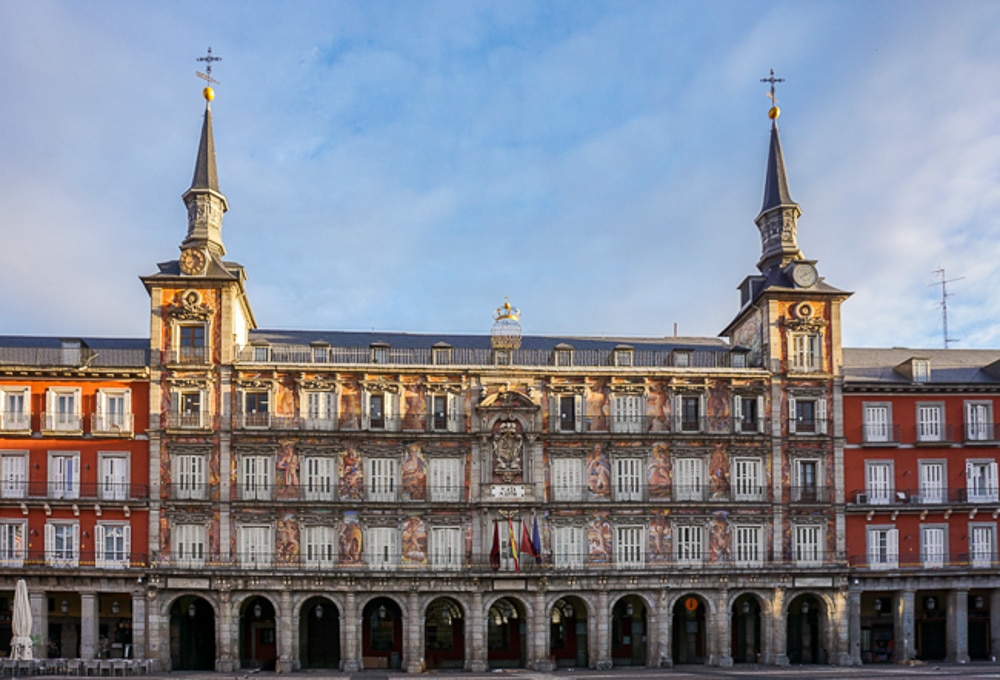
Once settled at your hotel, head out to explore fantastic Madrid.
Madrid has several must-see places and museums, not to mention the food! To maximize your time, it’ll be important to group the things you want to see and do by location to avoid crisscrossing the city needlessly.
My advice is to start with the Puerta del Sol area. It’s an active pedestrian zone perfect for walking and warding off any jet lag. Puerta del Sol is also where you’ll find Madrid’s famous bear and tree statue representing the city’s coat of arms.
Head towards Plaza Mayor. The history of this grand square dates back to the 1400s when it was Madrid’s central market square. Today, the regal King Phillip III statue at the center is surrounded by beautiful baroque buildings mainly from the 1800s due to fires that forced the city to rebuild and replace damaged ones.
Just near Plaza Mayor, enjoy some tapas bites at Mercado San Miguel. At this food hall, you’ll find all types of local tapas to sample from croquettes, meats, cheeses, and olive skewers. And if it’s your first time in Spain, sampling foods at this market is an easy way to get to know the local and regional flavors. Best of all it’s open until midnight most days and until 1 a.m. on weekends so you can go whenever you’re feeling hungry!
Explore Madrid’s Royal Palace, the largest royal palace in all of Europe with nearly 1.5 million square feet! It’s just a couple of minute’s walk from Mercado San Miguel. Today, it’s only used for official ceremonies and state dinners.
Be sure to book your timed entry tickets in advance. This way you can go at the time that works best for you and avoid waiting in the line that typically snakes from the entrance during peak times.
Next to the Royal Palace, you can also visit the Catedral de Almudena. The church is a modern (early 1900s) rebuild of an earlier one that was destroyed in a fire. The church is free to visit. Don’t miss the chance to take a photo of the Royal Palace from the top of the steps in the open courtyard next to the Royal Palace.
Depending on how you’re pacing and feeling, Plaza de Oriente and the Temple of Debod are worth a look. Plaza de Oriente is a small square opposite the Royal Palace with statues of former monarchs. The Temple of Debod is a real Egyptian Temple given to Spain by Egypt. From the park where it’s perched, there are also great views overlooking the Royal Palace.
Otherwise, take a casual stroll along the Gran Via, near Puerta del Sol, to shop and admire the gorgeous architecture. If you’d like to sit and enjoy something sweet, don’t miss San Gines. It’s the oldest chocolatier in the city, going back over 150 years. Their churros dipped in a decadent mug of thick chocolate are divine!
ProTip: Day 1 and Day 3 of this itinerary are interchangeable for the most part if you’d prefer to start off your time in Madrid Retiro Park and the city’s famous museums instead of at the popular places in and around the Royal Palace.
Day 2 – Day Trip from Madrid
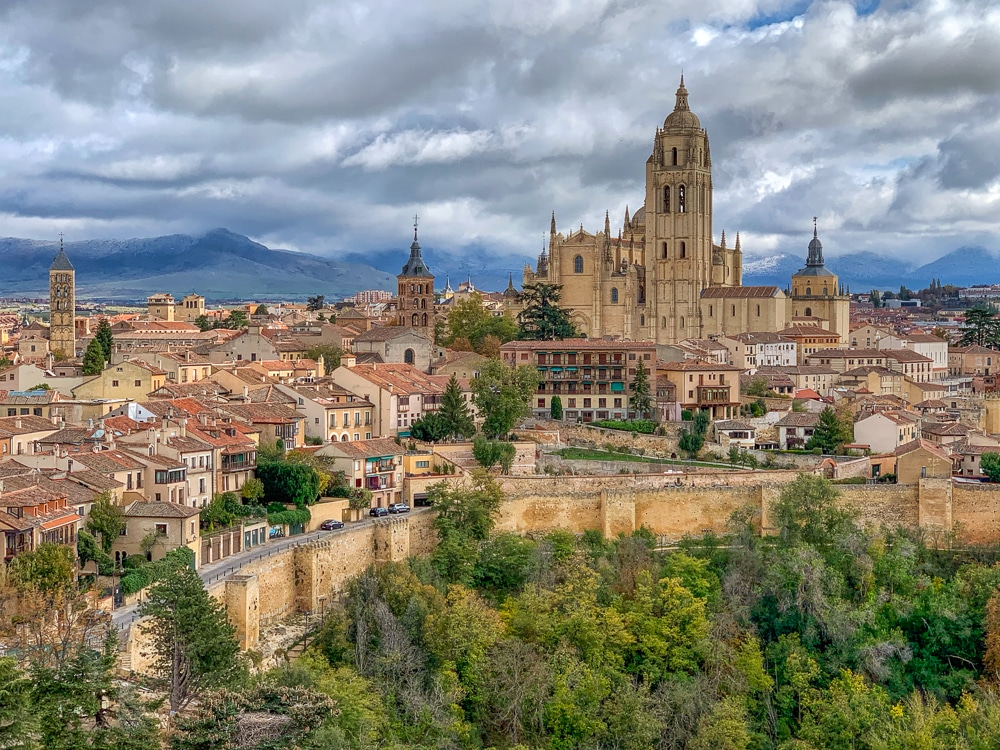
Spain for a week doesn’t mean you need to visit only 1 place. There are several popular and interesting day trips from Madrid and today is the perfect day to head out on one!
Toledo is easily reached by train. Segovia can be reached by bus, as can Avila and El Escorial. There are also organized day trips from Madrid that can handle all the logistics for you. One of the most popular combines visits to Toledo and Segovia to maximize your time.
Historic Toledo is seen as the crossroads of the 3 major religions and is steeped in history. The city goes back to the Roman times and has been recognized as a UNESCO World Heritage Site.
Segovia’s magnificent Roman aqueduct has stood for thousands of years, stone placed upon stone with no mortar(!) holding it in place. In addition, Segovia’s fairytale castle can be toured and the ramparts offer a fabulous view over the medieval city center.
Avila is a walled medieval town with a Cathedral built into its 11th-century walls and can be combined with a Segovia visit. While El Escorial is one of the Spanish Royal buildings, housing among other things a UNESCO-recognized monastery. It’s also the biggest Renaissance building anywhere in the world.
Regardless of which day trip you choose, plan to eat out in Madrid tonight. You can return to your hotel for a rest before savoring another delicious meal in Madrid.
If you’re up for it, head to Taberna El Sur for a tapas dinner. It’s roughly a 15-minute walk from either the Puerta del Sol or the Prado Museum area. It’s a classic spot with great food that takes you away from the touristy city center.
Day 3 – Madrid
Back in Madrid for today, make time to visit the Museo del Prado. It’s best to start the day here to get a jump on the many visitors the museum sees each day.
The Museo del Prado sits among Madrid’s trifecta of art museums along one of the city’s prettiest thoroughfares. The art museum holds some of the world’s most famous paintings dating back to the 12th century onward. Works by Raphael, Caravaggio, Bosch, Goya, and Velazquez are among the most popular in the museum.
Plan to spend a couple of hours seeing the museum’s highlights before museum fatigue sets in. Spain for a week means time is at a premium so get your Prado tickets ahead of time to avoid having to wait in the ticket line.
Retiro Park is nearby and should be your next stop today. It’s a must-visit while in Madrid and a great way to pivot from a museum morning.
The park once belonged to the Royal Family and has wide lanes for strolling interspersed with fountains, royal statues, and monuments. The city’s most popular green space, it’s also home to the Glass Palace. Sitting on the banks of the park’s duck pond, it’s a pretty spot any time of year. Inside, the Glass Palace hosts temporary exhibitions throughout the year.
With the afternoon open, choose to visit one of Madrid’s other famous art museums like the Museo Reina Sofia with its collection of contemporary Spanish art by Dali, Miro, and others.
Alternatively, the Thyssen-Bornemisza National Museum has a vast collection of art including Renaissance, impressionist, and American pieces, among others, on display. Remarkably, the collection was once owned by one (very rich) family!
If those museums aren’t for you, visit to Plaza de Cibeles, where you can’t miss the stunning Belle Epoque Cibeles Palace. You can go inside where you’ll find a tourist point, a cafe, a rooftop bar, an observation deck overlooking Madrid, and art exhibitions.
If you’ve used the Go City Madrid Pass to bundle your sightseeing costs, perhaps take advantage of an afternoon tapas tour!
Tonight, take an evening train to Barcelona. The high-speed train takes about 2 hours and given the typical late hour of dinner in Spain, you can plan on having dinner near your hotel in Barcelona.
Day 4 – Barcelona
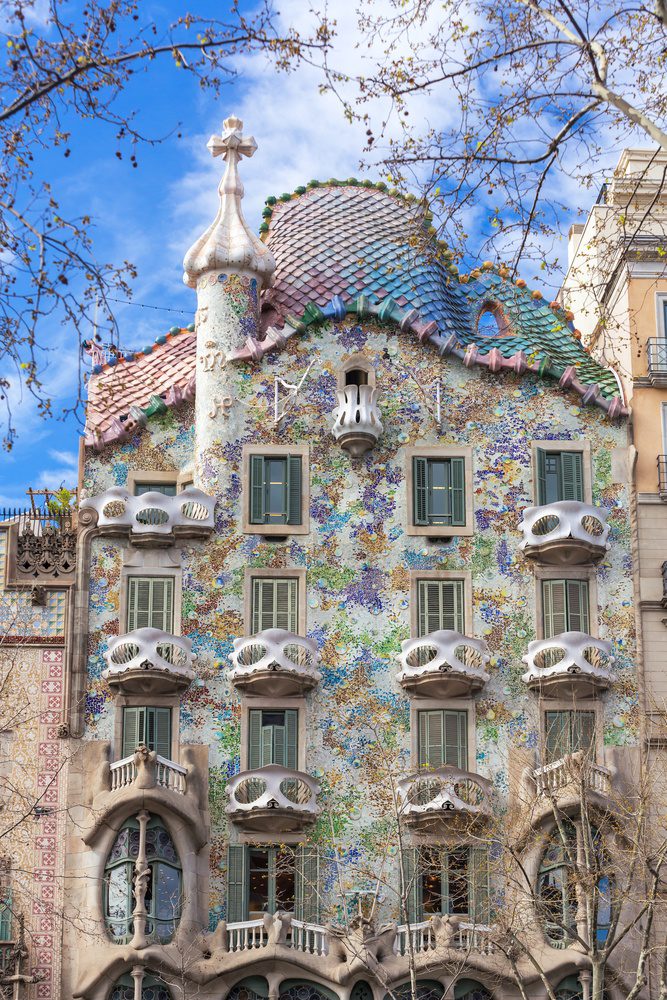
Barcelona is the home of all things Antoni Gaudi, the most well-known native Catalan architect and artist. The Sagrada Familia Cathedral is the crown jewel in a city of his architectural and design masterpieces. It’s a must-see when you’re in Barcelona and the perfect place to start your day in Barcelona.
The Sagrada Familia has been under construction since it began in 1882 and it’s scheduled to finally be completed in 2026! Even as is, the cathedral is breathtaking and its sculptures, windows, and layout are full of natural symbolism. It’ll rival the most beautiful cathedrals you’ve ever seen while still being distinctly different from any of them!
To ensure you don’t spend a lot of time waiting in line, book your timed-entry Sagrada Familia tickets in advance. It is the most popular place to visit in Barcelona. You don’t want to miss it or waste any of your one week in Spain waiting for an opportunity to enter. If possible, it’s worth it to add an audioguide so you can understand the symbolism inside and outside the cathedral.
In addition, Gaudi designed several private houses including the popular Casa Mila, also known as La Pedrera, and Casa Batllo. In fact, Casa Mila was Gaudi’s last house design and both houses have been named UNESCO World Heritage Sites.
Casa Mila’s iconic rooftop with chimneys and stairs transports you into a modernist, almost surreal, landscape of artist design. It’s one of the most creative architectural elements on any building anywhere!
You can walk from the Sagrada Familia to Casa Mila in just 15 minutes and Casa Batllo, with its glittering facade, is just 5 minutes on foot from there.
Casa Batllo sits on what is referred to as the “Block of Discord” because of a few other houses around it, also designed by modern-style architects. Undoubtedly, you’ll start to recognize some of the natural symbolism themes Gaudi displayed throughout many of his works.
Advanced tickets are recommended for these houses, as well, if you want a seamless visit without the wait times.
Also, by planning and reserving tickets in advance, you can easily see these 3 main Gaudi masterpieces and still have time to stroll Las Ramblas, Barcelona’s main pedestrian thoroughfare. The walkway is lined with souvenir hawkers, food carts, artisans, and street performers. It’s by far Barcelona’s most touristed area but you can’t miss seeing it at least once!
Along the way, stop to sample some bites at the famous La Boqueria market. It’s directly off of Las Ramblas and has some of the city’s most famous eateries like El Quim and Bar Pinotxo.
From here, you have options depending on your interests, timing, and when you visit Barcelona. If you continue down Las Ramblas, you’ll arrive at Barcelona’s pretty waterfront. You can stroll along the waterfront promenade to pass the harbor and even arrive at the beachfront!
If you’re interested in more Gaudi, there’s an early Gaudi house, Palau Guell, just off Las Ramblas, not far from La Boqueria. It, too, has been recognized by UNESCO, and the rooftop shows signs of Gaudi’s early musings of what would become the rooftop with chimneys at Casa Mila.
It’s also easy to wander into the palm-tree-lined Placa Reial on your way to Barcelona’s Gothic Quarter from Las Ramblas. The neighborhood is one of the true gems of the city. You’ll have time to explore more of this neighborhood on Day 6 of this itinerary, too.
Day 5 – Montserrat Day Trip from Barcelona
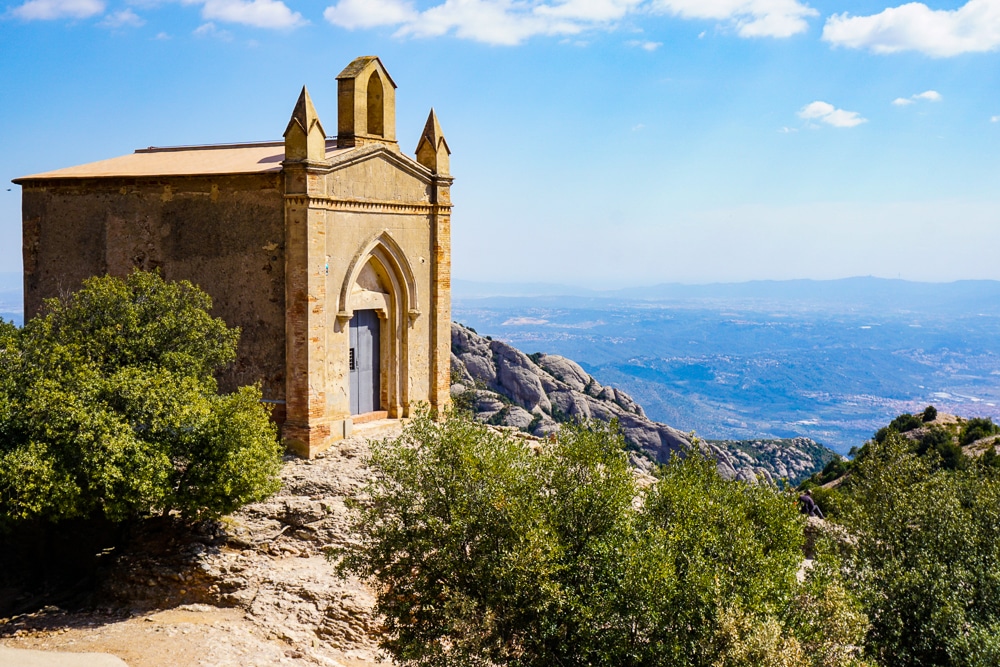
Day trips can do so much to enhance a trip! I love including them when I can. When you have 7 days in Spain, time can feel short in such a diverse and culturally rich country. But day trips go a long way to off-setting this!
So today you’re off to the mountains and Monastery of Montserrat, another UNESCO World Heritage Site. Located northwest of Barcelona, Montserrat is just an hour and a half by train from Barcelona but feels worlds away. The Abbey with the
The Basilica at the Montserrat Abbey is famous because of its Black Madonna, a wooden carved relic that has been the reason for pilgrimages for hundreds of years. It’s just one of a few in the world and it’s thought to have healing powers.
Today, people still flock to Montserrat to see the Black Madonna, pray, as well as hike to the chapels and overlooks in the mountains above the Basilica. If you’re able, I highly recommend going up to the mountains above the Abbey and even doing some hiking along the trails.
From the funicular rides up that carry you into the mountains and the walks and hikes you can do in and around the mountains, you’ll have the opportunity to take in sweeping views over Catalonia, the northeastern part of the country where Barcelona sits. You’ll also come upon chapels among the peaks that were once visited by pilgrims as they trekked into the hills.
The amount of hiking you do at Montserrat will determine how much time you need to spend. But it’s more than reasonable to spend some time at the Abbey when you arrive in the morning and head into the mountains above to take in the views, before returning to have some late afternoon and evening in Barcelona.
In fact, the day I went to Montserrat, I visited the Abbey and hiked some of the trails. Then, I returned to Barcelona with time to go to my hotel to change and refresh, before walking and eating at the fabulous Cal Pep in the Born neighborhood.
There are a few different ticket options for a DIY day trip to Montserrat Use this guide to plan and understand which option is right for you. Or if you prefer, you can go with with with a guide.
Day 6 – Barcelona
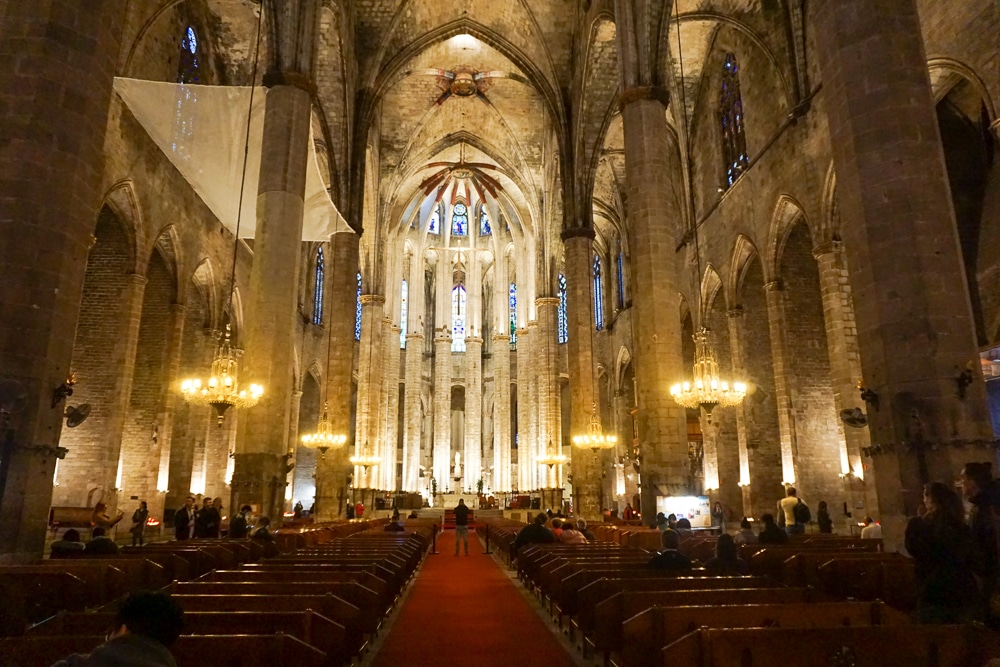
Get up early to visit Gaudi’s Park Guell. You’ll need to book your timed-entry tickets in advance to access the part of the park with his work. The mosaics and the views overlooking Barcelona are a great way to start your day.
When your visit is over, take the 20-minute metro ride back toward the city center. The L3 line going towards Zona Universitaria stops at Vallcarca, just a short walk from Parc Guell, to the Catalunya station, just steps from Las Ramblas.
Spend time today exploring Barcelona’s Gothic Quarter and Born neighborhoods. These are Barcelona’s oldest parts, dating back to the Roman Empire and the medieval charm is everywhere from the cobblestone streets to the water fountains.
The Cathedral of Barcelona, with its cloistered courtyard with swans and palm trees, and the Basilica of Santa Maria del Mar should not be missed. You can even go with a guide for a rooftop walk. If it’s available when you visit, it’s worth the experience!
The area is also home to Barcelona’s popular Picasso Museum. It’s one of the biggest collections of his work in the world, all housed in a series of joined medieval palaces. Nearby, you’ll find the Barcelona History Museum where you can see excavated Roman ruins left behind as a marker of the city’s past.
If you don’t plan to visit the Picasso or History Museum, and once you’re ready to leave the Gothic Quarter, ride the cable car to and from the Montjuic area for its historic and cultural sites, as well as the prettiest views over Barcelona and its waterfront.
The Port Cable Car, near the L4 Barceloneta metro stop, sweeps you up over the harbor and offers a birds-eye view of Las Ramblas before bringing you to the hill overlooking the city known as Montjuic.
Aside from the views, which are worthy enough simply to take the round trip cable car ride, Montjuic has a 17th-century castle, several art and architectural museums including one dedicated to the work of Joan Miro, as well as the Magic Fountain of Montjuic with its popular evening water and light shows.
The area has plenty to see and do, more than what you’ll have time for, but it’s a great way to expand your horizons beyond Barcelona’s Las Ramblas area.
And depending on the time of year of your visit and if you’re finished sightseeing, you just might want to spend the rest of the day relaxing on Barcelona’s beach or heading out onto the water for a sunset sail.
Day 7 – Departure
When you’re in Spain for a week, it flies by! There’s always city traffic to consider so ask your hotel what’s best as far as how long it will take to get to the airport. Fortunately, though, Barcelona’s airport is not far from the city center.
Depending on the time of your flight back home, you might even enjoy a morning stroll or breakfast out to take advantage of your last hours in Barcelona.
1 Week in Spain Option #2: Madrid & Day Trips
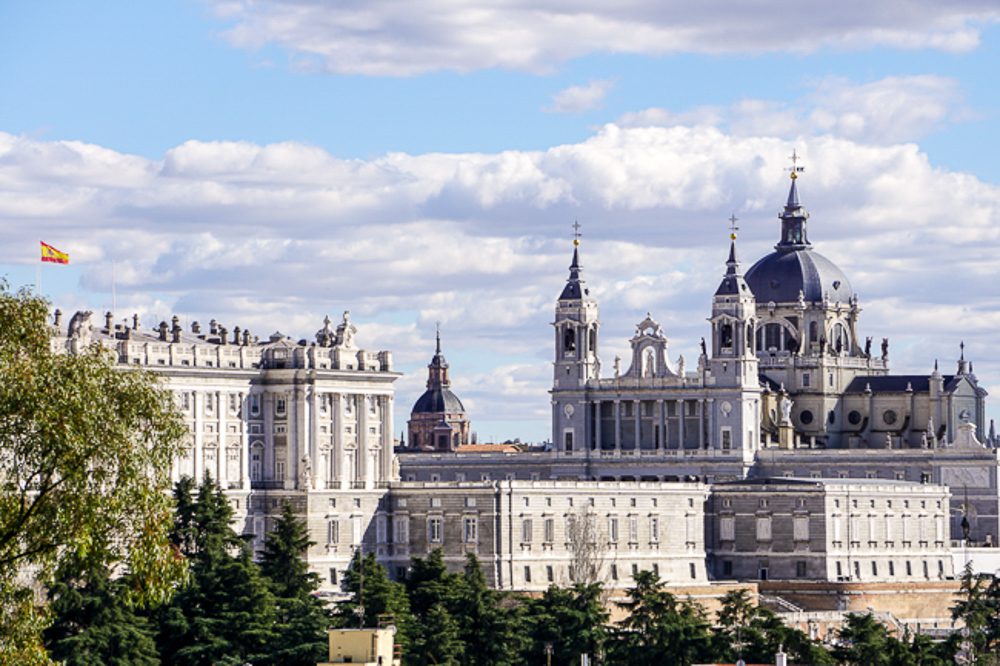
Getting Around
For this Spain trip, you’ll use a combination of Spain’s high-speed trains and buses to get from place to place.
Where to Stay
For this Spain in one week itinerary, you’ll spend the entire time in a Madrid hotel.
Days 1-3 Madrid
To plan your time in Madrid, use the details from days 1 and 3 in the itinerary above. In particular, with an extra day in Madrid, you’ll be able to enjoy more of the city’s famed art museums and do so at a more comfortable pace.
You’ll also be able to take more time to savor Madrid’s food. By basing yourself in Madrid all week, you can eat at a variety of restaurants for lunch and dinner to get a more local feel for the cuisine. You could even get a more guided or hands-on experience by joining a tapas crawl or taking a cooking class to learn how to make some classic Spanish dishes.
And even after you’ve done your days of sightseeing in Madrid, you’ll return to the city at the end of each day trip. This can really help you feel like you got to know a place whether that’s because you’re familiar with where to go or because you’re more comfortable wandering around and getting a feel for the pulse of daily life in Madrid.
Days 4-6 Day Trips from Madrid
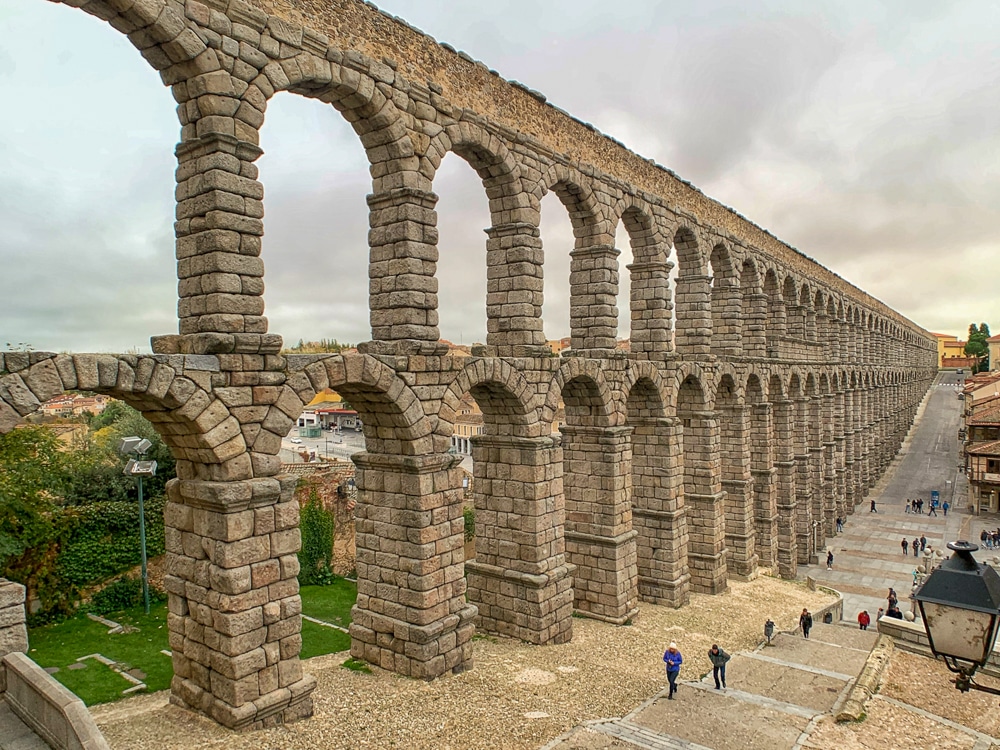
As you saw from day 2 in the itinerary above, there are several popular day trips within easy reach of Madrid. With 3 days to plan these out, this is my advice.
Spend 1 full day in Toledo. Whether you go by train or with a guided group, there’s plenty to see and do in this historic gem. Thought to be one of the oldest in Spain, Toledo is a UNESCO World Heritage Site with landmarks and historic sites related to the Christians, Muslims, and Jewish people who lived here.
You can split another day between Segovia and Avila. The easiest way to do this logistically is with an organized day trip. But you can also take the train from Madrid to Avila in the morning.
Later, take the bus from Avila to Segovia. Finally, you can take a bus from Segovia to Madrid. Just be sure to know all your times and where you need to be so that you don’t miss the bus you need.
El Escorial is another popular day trip, but likely will take less than a full day on its own. It’s one of the Spanish Royal buildings, home to a UNESCO-recognized monastery. It’s also the largest Renaissance building in the world today.
Other day trips from Madrid to consider are Cuenca and Salamanca, both of which can be reached by direct train from Madrid. Cuenca is just an hour away and is a walkable, manageable city to see in a day. It also has some of the most unique architecture with houses that “hang” off the cliff and over the gorge below.
Salamanca is 1 hour 40 minutes by direct train from Madrid. You probably can’t squeeze all of Salamanca’s sights into a single day but you can see its old and new cathedrals, check out Plaza Mayor, and admire the city’s gorgeous architecture. Did I mention that Salamanca is also a UNESCO World Heritage Site?
Day 7 – Depart
As detailed above, the airport train is a convenient and cost-effective way to return to Madrid’s airport. The ride takes just 20-25 minutes from Atocha Station. Depending on your flight time, you could even end up with a little morning bonus time in Madrid before departing.
If you prefer, arrange a car through Welcome Pickups to return to the airport.
1 Week in Spain Option #3: Barcelona, Madrid, & San Sebastian Highlights

Getting Around
No rental car needed! Use Spain’s high-speed trains to get from place to place.
Where to Stay
For this Spain in one week itinerary, you’ll base yourself for a couple of nights in all 3 cities.
How to Get from Barcelona Airport to the City Center
The simplest way to get from Barcelona Airport to the city center is by booking a private transfer. The airport is so close to the city itself that you’ll be at your hotel in a flash if traffic cooperates. It’s also a direct door-to-door service that eliminates you having to walk with your luggage or transfer to the metro once you’re in the city.
You can also take the Aerobus from Terminals 1 & 2 to central locations in Barcelona like Placa Catalunya close to the top of Las Ramblas. If your hotel is not close by to where you get off the bus, transfer to metro connections like those found at Placa Catalunya. Service runs 24/7 all year long. You’ll find ticket machines in both airport terminals.
RENFE airport trains connect Terminal 2 to points in the city, Estacio Sants and Passeig de Gracia. If you arrive in Terminal 1, you’ll need to take a shuttle to Terminal 2 to catch the train. Trains run about every 30 minutes and do stop running in the overnight hours.
Days 1-2 – Barcelona
For the first part of your one week in Spain, you’ll be in Barcelona. Follow days 4 and 6 of the itinerary above to plan out the things to do in Barcelona that interest you.
Because this Spain itinerary focuses on 3 cities, there isn’t time for day trips to places like Montserrat unless you cut back on the things you do in Barcelona. However, I wouldn’t recommend this. Not only is this a more chaotic pace, but you’ll inevitably miss out on so many great places and areas of Barcelona.
At the end of the 2nd day, take an evening high-speed train to Madrid. Doing the easy 2-hour direct ride in the evening makes the most sense so that you can start fresh in Madrid tomorrow.
Days 3-4 – Madrid
Having left Barcelona behind, you’ll feel the difference in city vibe as you start the day in Madrid. For starters, the city isn’t as touristy when compared to Barcelona so once you move past the main squares, the city feels more open.
Plan your days in Madrid using days 1 and 3 of the itinerary above. The difference in Madrid is if you don’t plan to spend time in any museums or only visit the Prado, it’s possible to do a whirlwind day around Madrid to save a half or full day for an excursion to a place like Toledo or Segovia.
I think Madrid deserves more than 1 day. However, if you’d like to do this, focus on seeing Madrid’s Royal Palace, the main squares, and the architecture around the Gran Via. Also, be sure to stop for some bites at Mercado San Miguel.
Spend the other part of the day visiting the highlights at Retiro Park. Save at least an hour for the Prado, if you’d like to see a bit of art.
Later in the day, make your way to San Sebastian. There are trains, buses, and flights to get you there so compare which one makes the most sense for your itinerary and budget.
Days 5-6 – San Sebastian
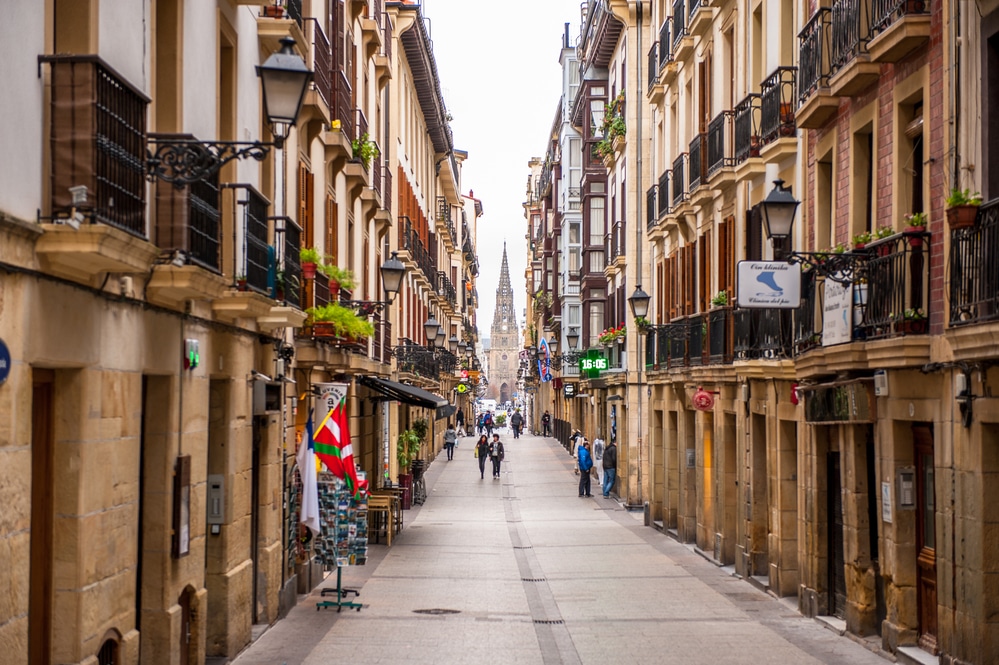
San Sebastian, also called Donostia in the Basque language, sits on the coast of the Bay of Biscay just 12 miles from the border dividing Spain and France. The city is blessed with an amazing food scene and cultural vibe along with stunning natural landscapes from the mountains to the sea.
The city is part of Basque Country, which is an autonomous region in northern Spain. To learn more about Basque history and the traditions of its people, I recommend visiting the San Telmo Museum in San Sebastian.
And while it’s tempting to head straight for the azure-colored waters of the Bay of La Concha, San Sebastian’s Old Town is a logical starting point for exploring the city. It’s here where you can stroll, eat, and visit some of the city’s famous sights.
Discover Constitution Square at the center of Old Town which used to be a bullring. Its arcaded perimeter and balconies from San Sebastian’s old town hall date back to 1817 and are a beautiful example of the city’s architecture.
Nearby, you’ll find some of San Sebastian’s most impressive churches including the 18th-century baroque Basilica of Santa Maria and the gothic Saint Vincent’s Church from the 16th century. While on the opposite edge of Old Town, you can visit the El Buen Pastor Cathedral (Good Shephard Cathedral), which is the city’s largest.
There is no shortage of places to stop for a bite. San Sebastian is known for pintxos, small bites of food on little toasts or skewers. But you’ll also find Michelin-starred restaurants if you’re looking for a dining experience. If you stop by the historic Brexta Market (where you can also eat), you’ll see where many of San Sebastian’s chefs do their shopping.
Take note of the lines coming from 2 places in particular. La Vina is where you’ll find San Sebastian’s famous “burnt” cheesecake. While Ganbara is a restaurant with exceptionally delicious dishes made even more famous after Anthony Bourdain included his visit there as part of his documentary series.
San Sebastian is also surrounded by 3 mountain peaks, Urgull, Igeldo, and Ulia.
Mount Urgull is closest to Old Town and can be summited by starting with the stairs that are next to San Telmo and following the paths that lead to the panoramic viewpoints at the top. Besides the gorgeous views overlooking the beach and the city, you can explore Mota Castle, a defensive fort from the 1100s.
Mount Igeldo is on the opposite side of the bay and can be reached using the original wooden funicular dating back to 1912. At the top, there’s an amusement park open at certain times of the year. However, the views overlooking the city, the bay, and Santa Clara Island steal the show!
Mount Ulia is in the Gros neighborhood across the Zurriola Bridge. There’s a surfing beach, as well as a lot of really delicious cafes and restaurants in the area. You can walk along several paths to make the 20-30-minute walk up to the top.
And of course, you’ll want to take time to enjoy San Sebastian’s La Concha Beach! It’s considered one of the prettiest beaches in all of Europe. So whether you want to walk along the promenade to admire the views and Miramar Palace, lay out your own towel, or rent a beach chair and umbrella, the gorgeous stretch of coastline is a can’t-miss.
Day 7 – Depart
After 2 days of savoring every bite of San Sebastian and 1 week in Spain, you’ll make your way home today. From San Sebastian, you can fly with a connection back to North America or to other points in Europe and beyond.
1 Week in Spain Option #4: Barcelona & Day Trips
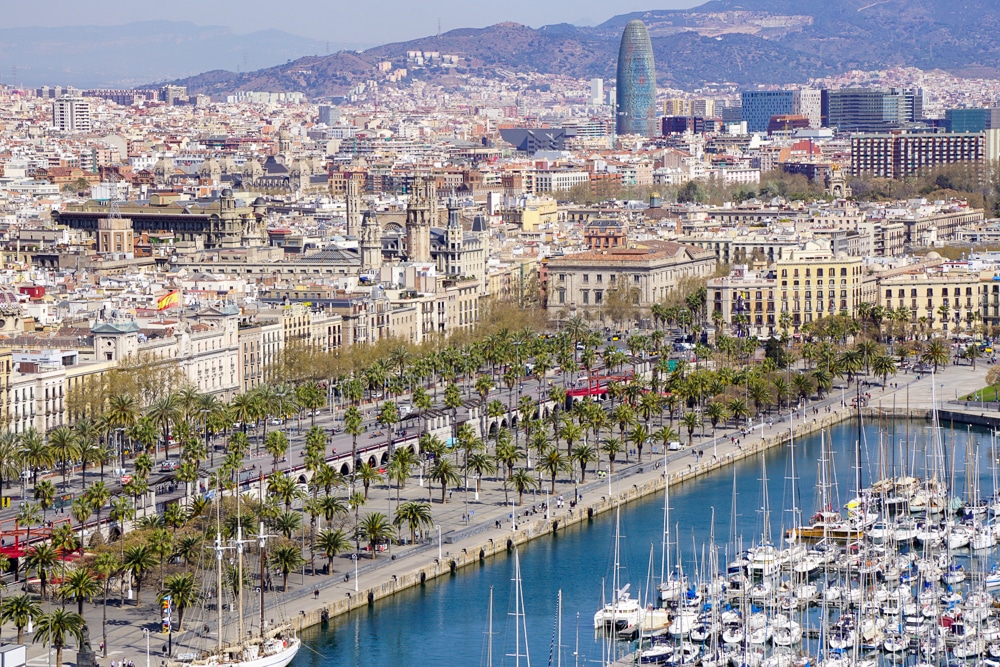
Getting Around
For this Spain trip, you’ll use a combination of Spain’s high-speed trains and a rental car to get from place to place.
Where to Stay
The beauty of this Spain in one week itinerary is that you stay in a single base. No need to lug bags from hotel to hotel, yet still visiting some of Spain’s top sights and destinations!
Days 1-3 Barcelona
With 3 full days in Barcelona, you’ll have time to give some of the areas of the city more of your attention instead of just glimpsing the highlights or skipping them altogether.
For starters, use days 4 and 6 in the itinerary above to begin to organize your time. I still recommend grouping activities that are within proximity to one another like the Sagrada Familia and the 2 most popular Gaudi houses, Casa Mila and Casa Batllo.
However, with more time, you’ll be able to spend more time in the Born neighborhood, as well as give the Montjuic area its full due. Taking the cable car up to the hill is just the beginning. There’s a lot to explore including a castle and a museum dedicated to the work of Joan Miro.
Not to mention, Barcelona’s unique position along the coast offers visitors the chance to get out onto the water by boat to see the city from another perspective.
And, as with the Madrid and Day Trips itinerary above, you could also use the extra time to do a guided activity like a food tour because as much as 1 week in Spain is about history, art, and sightseeing, it’s also about tasting as much of the local cuisine as possible!
Day 4 – Montserrat Day Trip from Barcelona
You should still plan to spend a day at Montserrat as described in day 5 of the itinerary above. The combination of the historic monastery and the hiking trails into the hills along former pilgrimage routes adds up to be one of the best day trips you can take from Barcelona.
The mountains and the views you’ll have from them are spectacular and will make you feel worlds away from the pulse of vibrant Barcelona.
Days 5 – Girona Day Trip from Barcelona
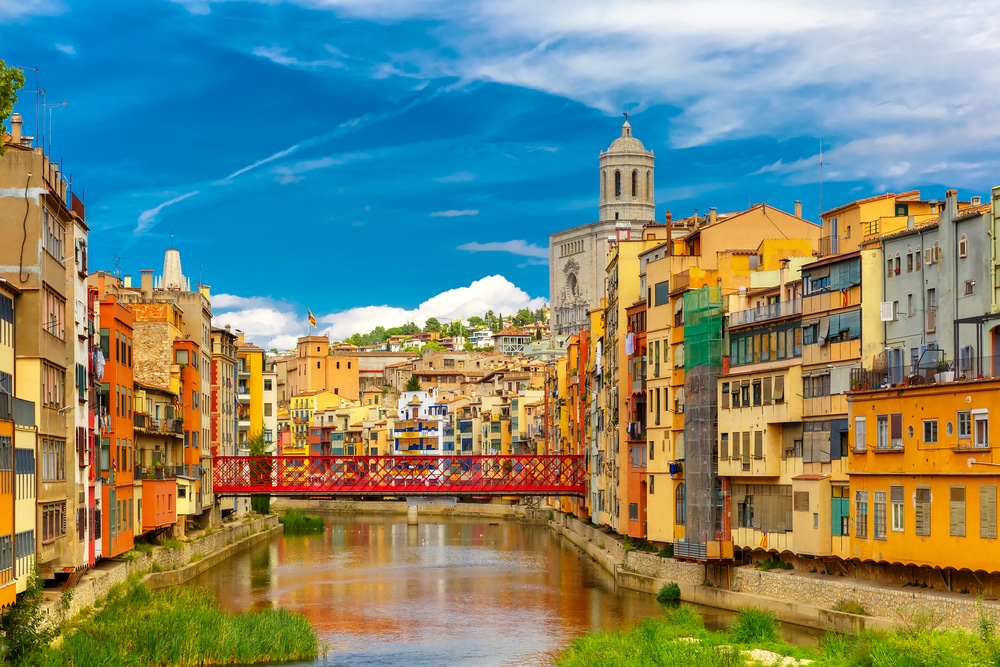
As you plan these 2 days with day trips from Barcelona, know that you’ll have to choose from a lot of terrific options. It’s exactly why Spain is a destination that continues to lure you back and I’ve fallen victim several times!
After Montserrat, Girona is the next most popular place to visit from Barcelona. The city’s history spans 2,000 years. It has one of the best-preserved Jewish quarters in all of Europe. The labyrinth of intertwining streets transports you back to medieval times. It was also used as a filming location for Game of Thrones.
Luckily, it’s easy to visit for a day on your own. You can take a direct train from Barcelona and arrive in Girona in less than 40 minutes. Start early so you can get a jump on the many other day trippers and groups also heading to Girona.
You can also go with a small guided group which will help you know more of the history as you walk around. Plus, most tours include a couple of other stops at 1 or 2 places along the Costa Brava.
Once there, take time to visit the Cathedral and get some photos from the dramatic staircase leading to the entrance. Wander around the Jewish Quarter and to learn more about the Jews who once lived in Girona visit the Jewish Museum.
Walk along the Onyar River for that iconic shot with Girona’s colorful houses. Look for the Pont de les Peixateries Velles. It was built by Gustav Eiffel…the one and only who also designed the Eiffel Tower.
Girona also has walls around the city, known as the Passeig de la Muralla, where you can walk. This is a great way to get beautiful views over the city and get a better understanding of how Girona is situated.
Day 6 – More Day Trip Options from Barcelona
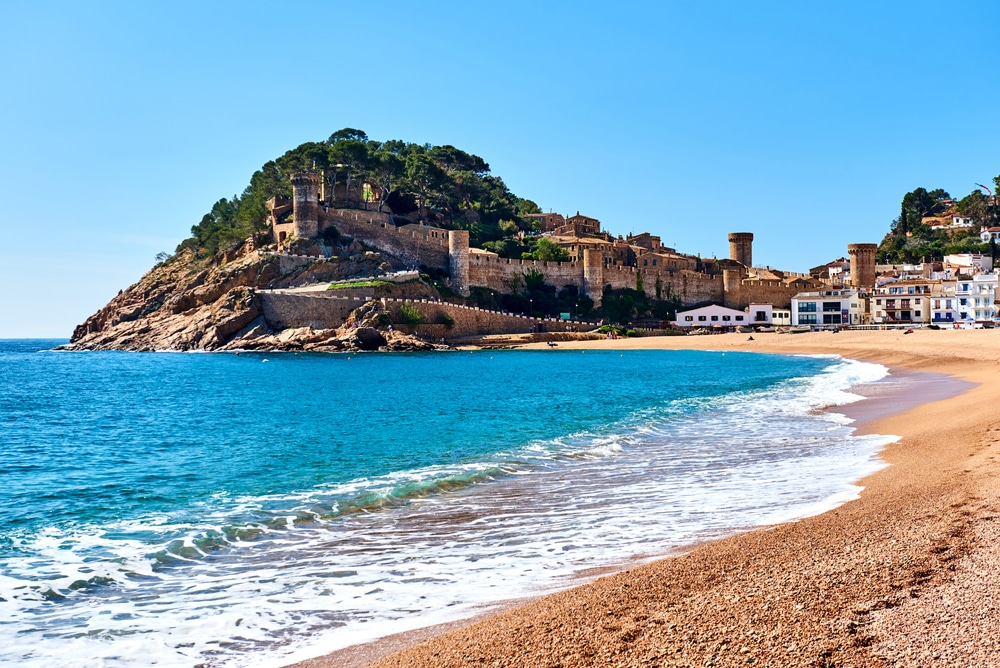
After spending a day in Girona, your last day trip depends on what you want to do and the time of year you visit.
If you are a beach-lover and it’s between May and September, the gorgeous Costa Brava awaits. In particular, you can take the bus to Tossa de Mar for a day of beach, sun, casual strolling, and delicious seafood. You can also take the hassle of the logistics out of it and get to Tossa de Mar with this guided visit that also includes free time to enjoy the beach.
South of Barcelona along the coast, you can visit Tarragona and/or Sitges. A few organized day trips like this one include both. Sitges boasts gorgeous beaches and a vibrant artist community, along with cobblestone lanes, watersports, and hiking trails. Tarragona also sits along the sea and has incredible Roman ruins.
Both of these seaside towns can be reached by train and bus and are most popular to visit during the warmer months given their beach access.
Lastly, you could join a Dali-themed guided day trip to Cadaques and the Dali Museum and House. Or even consider this unique day trip that takes you between 3 European countries (Spain being one of them) on the same trip.
Day 7 – Depart
Spain in one week goes by fast! But no doubt, you’ll want to return soon to see more of this beautiful country. Barcelona’s airport is less than 10 miles from the city center so you can be there in no time as long as traffic cooperates.
Depending on what time your flight is, you could even take one last morning stroll or have breakfast one more time at your favorite cafe.
1 Week in Spain Option #5: Madrid & Day Trip with a Taste of Andalucia
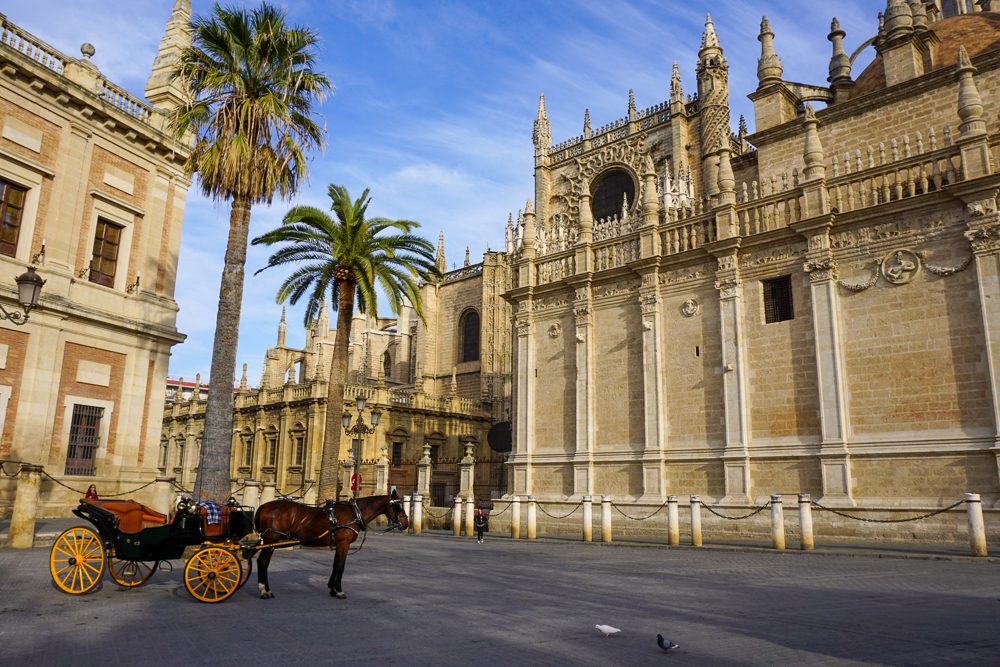
Getting Around
No rental car needed! Use Spain’s high-speed trains to get from place to place.
Where to Stay
Use Madrid and Seville as your 2 “bases” during your trip.
Days 1-3 – Madrid & Day Trip
For the first 3 days of this one week in Spain itinerary, follow the itinerary as above for Madrid. With this option, you’ll spend 2 days exploring Madrid and 1 day choosing a day trip from Madrid.
On the evening of Day 3, however, take the high-speed train from Madrid’s Atocha station to Seville. The ride is about 2 and a half hours, with many trains running between Madrid and Seville each day.
Depending on the time you arrive, you’re likely to find Seville’s Santa Cruz neighborhood buzzing with energy from the outdoor dining lining the streets, not to mention scents of delicious meats, fried fish, salmorejo, olives, and plenty of other mouth-watering Spanish flavors.
If you visit in spring, you’re also sure to smell the fragrant orange blossoms in bloom throughout the city.
If you’re up to it, head out and wander through the Santa Cruz neighborhood. You can have dinner, but also get oriented for the next day.
Day 4 – Seville
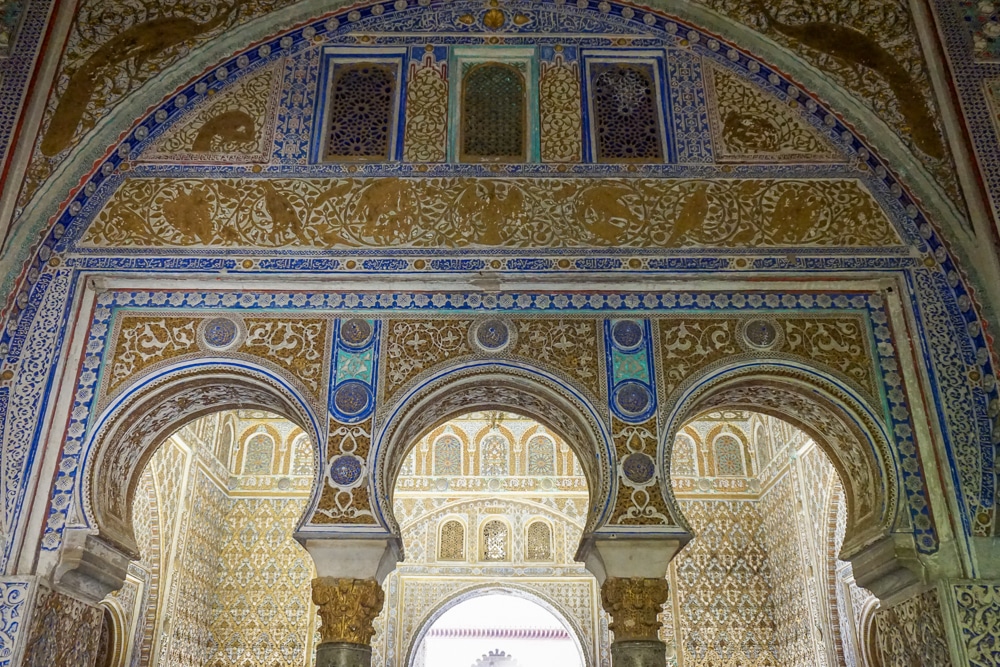
Welcome to Andalucia! In this region of Spain, you’ll see the blended result of Moorish and Christian influences over thousands of years of conquest and reconquest. Everything from the architecture to the food is a vibrant fusion that’ll sweep you off your feet!
On your first day in Seville, plan to see the stunning Real Alcazar, perhaps the best example of this cultural fusion in all of Spain, and the Cathedral of Seville, both UNESCO World Heritage Sites. They’re situated just near one another so logistically it’s easy to see both back-to-back.
You must get tickets to the Alcazar in advance. There are limits to the number of people who can enter each day. It’s not uncommon to see those who haven’t booked tickets in advance standing in line outside even before the sun comes up to try and snag last-minute tickets should they be available.
The Alcazar palace’s colorful tilework and intricate, hand-carved designs on the walls are exquisite and complement the architecture. As you walk from room to room, you’ll be in awe over the artistic mastery it must have taken to complete something of such beauty. The gorgeous gardens are a sight to see at any time of the year, but especially in spring when the orange blossoms and purple wisteria are in bloom.
The Alcazar’s history isn’t obvious as you walk around, though. So to learn more about the palace and the Moorish history of Seville and Southern Spain use an audioguide or book a guided Alcazar tour.
Plan to spend at least a couple of hours at the Alcazar to tour the inside and then the exquisitely laid-out gardens awaiting outside.
When you’re done and depending on the time, it could be perfect to sit down for lunch or just a midday break with some tapas and a glass of wine.
Once you’re refreshed, the Cathedral of Seville awaits.
At one point, this Cathedral was the largest in the world. Today, it’s the 4th largest. Originally it was built as a Mosque in the 1100s, before being converted to a Cathedral when the Christians retook control of Southern Spain in the 1200s.
The former Mosque minaret was converted into a bell tower and is known today as La Giralda. Climb to the top using the ramps for a pretty view over Seville, the Cathedral, and its orange grove in the inner courtyard.
Within the Cathedral itself, everything from the nave to the choir loft to the carved scenes and stained glass retelling the story of Christianity is a work of art in its own right. The Cathedral also claims to be the final resting spot of Christopher Columbus and his son, along with other royal and historic figures.
Once you’re Cathedral visit is over, spend some time walking through the Barrio Santa Cruz. This neighborhood’s medieval streets and alleyways are in and around the Alcazar and the Cathedral. It’s a historic area, having been the city’s former Jewish Quarter. Today, you can browse in the shops selling everything from clothing to art to spices.
It’s also a great area to sit for some tapas and a drink. Santa Cruz abounds with so many places to eat, it’ll be hard to choose! If it helps, Las Teresas was one of my favorites!
As the afternoon winds down, walk to the spectacular Plaza de Espana. It’s one of the most gorgeous plazas you’ll see anywhere in Europe!
Built in 1928 with Renaissance and Moorish Revival themes, the plaza’s walls are covered with beautiful tile work. The buildings along the perimeter of the square arc into a half circle while a moat and arched bridges connect the design to a striking fountain. It’s an absolute can’t-miss while you’re in Seville.
The best time to go is later in the afternoon because you’ll get to see the plaza in the daylight and as the lights turn on for a luminous display of the architecture and art Spain is known for.
If you arrive with a bit of time to spare, Parque de Maria Luisa runs alongside the Plaza de Espana and is a pretty place to stroll.
As you head back to the city center of Seville for dinner, you could include a Flamenco show in your plans. The storytelling-dance art form has deep roots in Andalucia, making it the best place in Spain to attend a show.
Day 5 – Cordoba
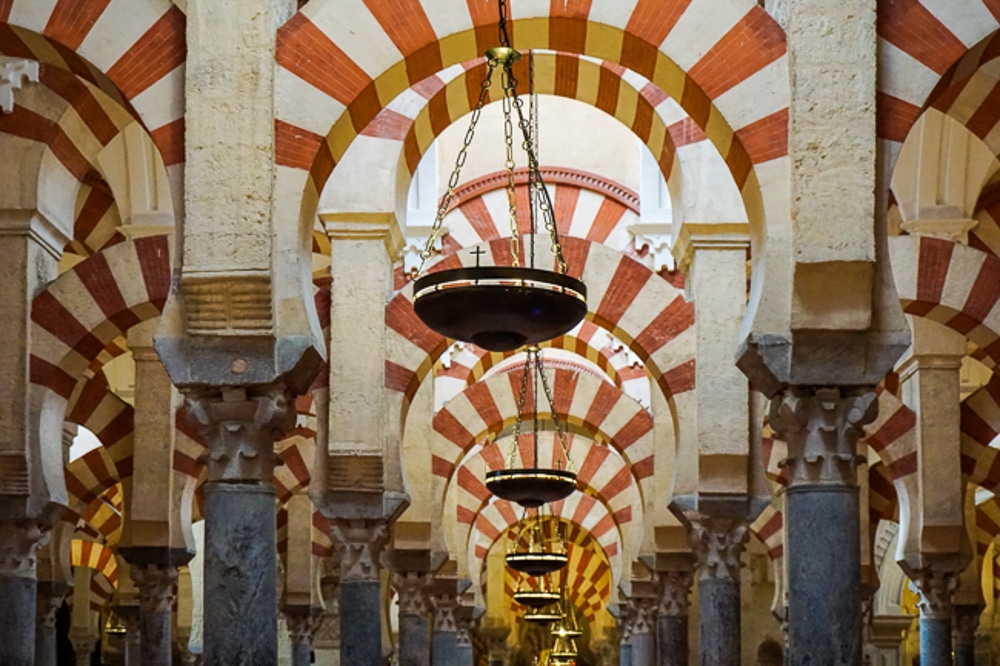
As dazzling as Seville is, it’s only the gateway to all southern Spain has to offer. Luckily, Spain for a week still gives you the chance more of the region. So, today take the 45-minute train ride to unforgettable Cordoba. Make an early start. Cordoba has a lot to see and do!
This spectacular ancient city is not to be missed while in southern Spain. Cordoba was conquered by the Romans in 206 B.C. and over thousands of years was ruled by the Romans, Visigoths, Moors, and Christians. What’s left behind today is a city with ancient architecture, history around every corner, and a fusion of style, food, and cultures.
The city boasts 4 UNESCO World Heritage Sites, all of which are worth the time and effort to see.
By far the most famous of Cordoba’s sights is the Mezquita or Mosque-Cathedral. Built as a Mosque in 785 and eventually converted to a Cathedral in the 16th Century, this historic sight never fails to take my breath away no matter how many times I’ve been fortunate enough to visit.
The blend of architecture between the Islamic and Christian styles comes through in features like the minaret (now a bell tower), the open space as you enter adorned with red and white striped arches, and the main altar of the Cathedral.
Get your Mezquita ticket in advance or book a guided tour to avoid waiting in line, as well as to learn more about this incredible, historic place. This is the most popular place to visit in Cordoba and will undoubtedly have a line to enter.
The Palace of the Christian Kings is another top sight in Cordoba. Built as a fortress in the 1300s, it eventually was where Queen Isabella and King Ferdinand called home as they worked to reclaim southern Spain from the Moors.
Today, the castle’s structure is still remarkably intact and well-preserved. The UNESCO site also has gorgeous gardens and 4th-century Roman frescoes that shouldn’t be missed.
These 2 sites, and several others, are a part of Cordoba’s Old Jewish Quarter known as La Juderia. This historic neighborhood has been named a UNESCO World Heritage Site all on its own. Take the time to wander around and you’ll see why!
The white-washed buildings, signature wall-hung flower pots, and the mosaic tile work are the essence of the cultural beat that pulses through southern Spain. Along the way, browse at some of the shops and be tempted by the scents of rosemary and saffron coming from the cafes and restaurants.
As you walk, peak down Calleja de las Flores lined with vibrant flower pots. Stop to admire the Puerta del Puente and the Roman Bridge. Taste some of Cordoba’s traditional salmorejo, a cold and creamy soup similar to Gazpacho.
After lunch, make the trip to Medina Azahara, Cordoba’s 4th UNESCO site. It’s located just a few miles outside of Cordoba’s city center and dates back to the 900s when Abd-ar-Rahman III wanted to show off the power of his kingdom.
The site has been partially excavated to reveal what was once a bustling city where up to 10,000 people may have once lived. The architecture that has been preserved contains stunning arches, columns, and even a palace.
Cordoba is also famous for its patios. In fact, each May the city’s patio festival opens up numerous private patios for public viewing. Typical Andalucian homes have an internal patio with flowers and a fountain to take respite from the summer heat.
But even if you don’t visit in May, the Palacio de Vianna is a 15th-century palace museum that showcases 12 different styles of Cordoba’s characteristic patios that you can visit year-round. It’s just a 15-minute walk from the Mezquita.
Then, after a full day savoring Cordoba, take the train back to Seville. You’ll likely return in time for Spain’s typical late dinner.
Day 6 – Seville
Back in Seville today, begin at Casa de Pilatos in the Santa Cruz neighborhood just a short walk from the Cathedral. This Renaissance and Moorish palace is an absolute gem of art and architecture, adorned with Spanish tiles and Roman mosaic designs. True to the style of many Andalucian homes, there’s a beautiful inner courtyard in the center with a fountain.
Visitors can tour the ground floor and one of the gardens independently, but an upgraded ticket also gets you guided access to the upstairs portion of the palace. You won’t want to miss fully exploring this stunning and well-maintained 16th-century Andalucian palace.
Then, make your way past the Cathedral and towards the Guadalquivir River to admire the Torre del Oro. It’s a defense tower built in the 1200s that today allows visitors to climb for a view over the city.
Walk along the riverfront promenade toward Puente de Isabel II, the bridge that leads into the Triana neighborhood. Along the way across the street, you’ll see the Plaza de Toros, Seville’s royal bullring dating back to the 1760s.
Walk across the bridge into Seville’s Triana area. You’ll see the Mercado de Triana on the right as you reach the other side. This indoor local market has vendors selling meats, fish, baked goods, and produce. You can also get prepared food or sit at one of the cafes or breweries.
The market also has a cooking school inside if you were hoping to learn how to prepare your favorite Andalucian dish back home.
The Triana neighborhood will have a more local feel compared to the area in and around the Alcazar. Walk around to discover the shops and cafes in the area. If you resisted all temptations at the Mercado, find an open table at one of the neighborhood restaurants.
Also, take note of the ceramics shops. Seville and Triana, in particular, are known for ceramic tiles and pottery. If you were hoping to buy a ceramic souvenir, Triana is the place to do it.
Later in the afternoon before heading back to the city center, you might want to take a detour to Metropol Parasol. This wooden structure is unlike anything you’ve seen so far in Seville. In fact, its nickname is “the mushrooms” because of how it looks.
The main draw is to go to the top to see the city views, especially at sunset. You can also go to the lower level where there’s a small history museum with ruins.
If you haven’t yet, what better way to spend your last night in Spain than enjoying a flamenco show along with as many last bites of your favorite Spanish food!
Day 7 – Depart
Take an early morning train from Seville back to Madrid for your flight home today. Your train will arrive back at Atocha Station, where you can take the RENFE C1 or C10 train back to the airport.
My husband and I have done this exact journey, leaving Seville by 7 a.m on the high-speed train to Madrid, needing roughly 3-3 1/2 hours total to arrive back at the airport with enough time before our flight. Of course, you can also reposition back to Madrid the night before.
However, I prefer this early morning option when possible because it allows for the 6th day of the itinerary to be spent totally enjoying Seville. It also saves you from moving your luggage to another hotel back in Madrid for just an overnight stay before heading to the airport.
There are also good hotels near the airport in Madrid. On one of my trips to Spain, I stayed in this one. But, keep in mind, there’s not much in the area so staying here would be just to transfer to the airport when it’s time.
1 Week in Spain Option #6: A Week in Andalucia
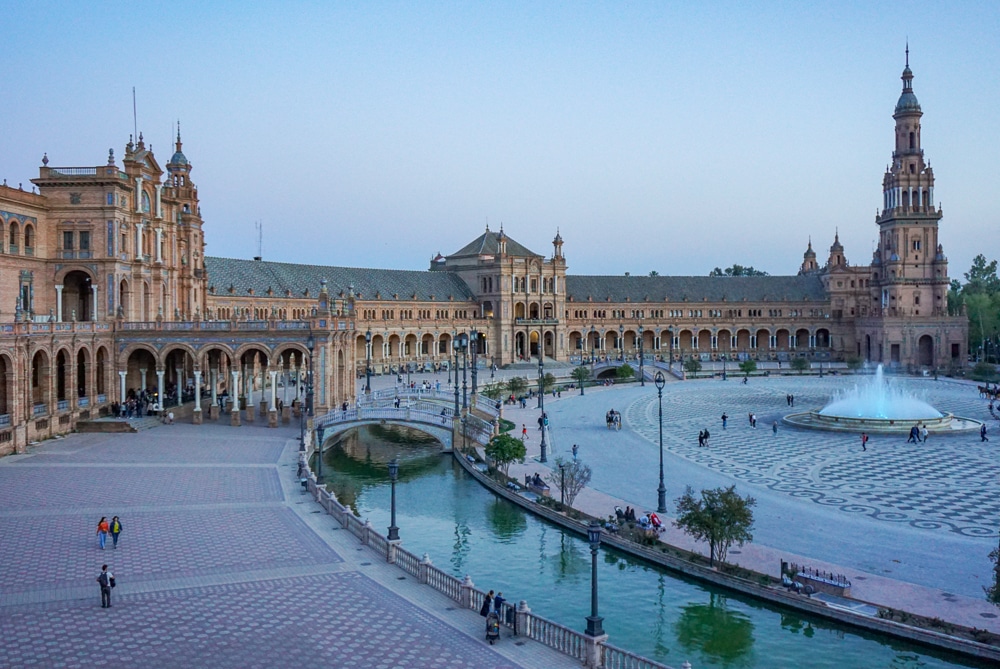
Getting Around
For this Spain trip, you’ll use a combination of Spain’s high-speed trains and a rental car to get from place to place.
Where to Stay
You’ll have several bases with this southern Spain itinerary. But you’ll also get to see some incredible destinations!
Perhaps you’ve already visited Barcelona and Madrid and would like to experience a new part of Spain. Or maybe the south of Spain has been on your travel to-do list for a while and you’re finally able to make it happen.
Spain’s Andalucia (Andalusia in English) is known for its food, culture, history, and architecture. There’s a lot to see and do with just one week in Spain and no shortage of UNESCO World Heritage Sites or beautiful towns and white villages to explore.
Days 1 & 2 – Seville
Fly into Madrid and take the train as explained above to Seville.
There are no direct flights to Seville from the United States. But, you can connect to a flight directly to Seville.
Iberia has flights between Madrid and Seville. TAP Air Portugal has flights between Lisbon and Seville. Other flights connect from popular European cities like London and Paris to Seville. Compare timing and prices to see if the train from Madrid or a connecting flight makes the most sense for your itinerary.
Once you are settled in at your hotel in Seville, use the itinerary above for Days 4 and 6 in Seville. Depending on the time you arrive, it’ll probably be better to visit the Alcazar in Seville on your second day just in case something happens and you are delayed in arriving in Seville.
Day 3 – Cordoba
Today, take a day trip to Cordoba as described above. It’s just a 45-minute train ride from Seville and is one of the most spectacular towns in southern Spain.
Alternatively, you could take the train from Seville to Cordoba and plan to stay the night in Cordoba. The city’s main sights like the Mezquita and the Palace of the Christian Kings will take a few hours to visit. Plus, the UNESCO-recognized Medina Azahara is located just outside the city center and is well worth the time to visit.
Day 4 – Ronda
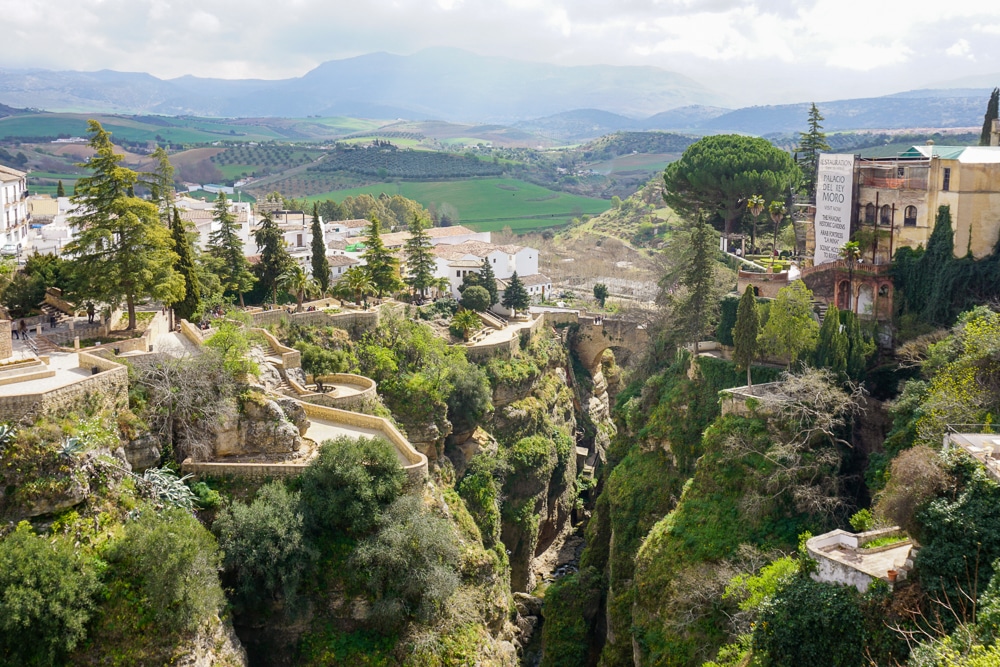
Pick up your car as early as possible and set off for Ronda. (If you prefer, pick up the car the night before or you can even plan to drive from Seville. Just be sure to make an overnight parking plan for Cordoba. Not all hotels offer it and street parking is a challenge.)
The drive from Cordoba to Ronda is about 2 hours. (The drive from Seville is roughly the same.) Once you arrive in Ronda, plan to park outside the old town in one of the paid public lots like this one. From there, you can easily walk into the historic part of town.
Postcard-perfect Ronda sits atop the El Tajo gorge with its famously dramatic Puente Nuevo which spans across the plunging ravine. It’s an absolute must-visit while spending a week in Andalucia.
The Puente Nuevo, or new bridge, is in the heart of Ronda’s old town and is where most visitors start their day. From left to right, the views encompass Ronda’s white-washed buildings and the lush countryside with olive and almond tree groves dotting the hills.
Around the bridge, you’ll find hiking trails that allow you to see the Ronda and its famous bridge from a different perspective, as well as restaurants and cafes where you can sit and enjoy the views. You can also stroll the winding path to the Jardines de Cuenca to see the gorgeous gardens nestled into the canyon’s cliffs.
Nearby, you can make a stop to see Ronda’s Plaza de Toros, potentially the oldest and largest bullring in Spain. Either way, it’s worth a stroll in this direction because the Alameda del Tajo is a park and promenade just next door with spectacular views of the gorge.
As with most all of the towns and cities in southern Spain, the Moorish and Christian mix of influences is everywhere you look. The historic Arab Baths date back to the 13th and 14th centuries and used to sit next to a Mosque. These baths are remarkably preserved and are one of Ronda’s most popular historic sites.
Next, head towards the Plaza Duquesa de Parcent, also known as Ronda’s Plaza Mayor. It’s Ronda’s Moorish center and one of the prettiest squares in the town.
The Iglesia de Santa Maria la Mayor is a historic church in the square that was built in the 1500s upon a former Mosque. Make a stop to see the artwork inside and then climb to the top for a panoramic glimpse over Ronda.
If you have more time to spare, consider stopping at Mondragon Palace or Casa Museo Don Bosco to see historic houses that spotlight the artistic tile work, water features, and architectural elements Andalucia is known for. Or instead, visit the secret water mine and gardens at Casa del Rey Moro!
Tonight, choose to stay at a hotel in the heart of Ronda or at one of the agritourism properties in the countryside just outside of town.
ProTip: Whether you drive away from Ronda at the end of the day or the next morning, be sure to navigate to Mirador La Hoya del Tajo on Google Maps to get some photos of Ronda’s iconic Puente Nuevo from the bottom of the gorge.
Day 5 – White Villages, Malaga, and/or Caminito del Rey
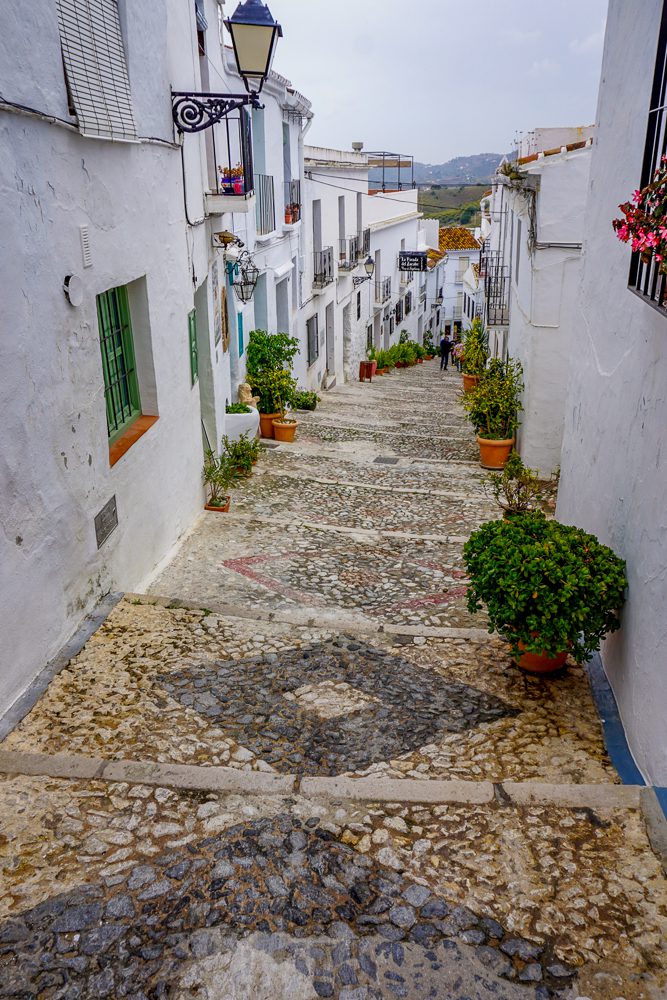
Today, there a few options depending on what you’re interests are. I’ll explain each one so you can choose your own adventure!
Part of any southern Spain itinerary must include at least a day in the region’s white villages, or pueblos blancos. Technically, Ronda is one of these white villages, but to really get a sense of these villages, you’ll need to venture into the countryside to some of the smaller white-washed gems.
You could spend the full day hopping for villages like Setenil de las Bodegas, where the homes have been carved right into the cliffside. Antequera is a historic gem with Roman ruins, a 14th-century Moorish castle, and the UNESCO-recognized dolmens of Menga, Viera, and El Romeral.
Afterward, head south toward the southern coast of Spain and see the breathtakingly beautiful Frigiliana. With nothing in particular to see except this beautiful white village, stroll the pebbled lanes admiring the vibrantly painted doors, buying some Andalucian souvenirs, and enjoying the view from a cafe.
Another possibility is to spend the morning doing the Caminito del Rey walk to enjoy the stunning natural beauty of the region. This nearly 5-mile path travels along rocky paths and walkways that have been suspended over 300 feet in the air through the gorge carved by the Guadalhorce River.
You can choose from shorter or longer trail options and use the shuttle to get back to where you parked your car. After a morning of hiking, choose to have lunch and stroll through a white village like Antequera or Frigiliana.
As a third option, you could spend the day in Malaga. This pretty port city is the birthplace of Picasso and has a fantastic museum of his work. There are Roman ruins like a 1st-century amphitheater and historic Moorish sites like the Malaga Alcazaba and Gibralfaro Castle with spectacular views over the city and the sea!
Malaga also has a beautiful harbor promenade, beautiful architecture, exotic green parrots, and spots where you can enjoy some time on the beach.
Whichever you choose, ultimately, you want to end the day by arriving at your accommodations in Granada. It’s not a long drive. From any of these options, you’ll finish your day not 60-90 minutes from Granada. Be sure your hotel or B&B has available parking. You could even plan to return your rental car tonight to avoid paying for parking.
Day 6 – Granada
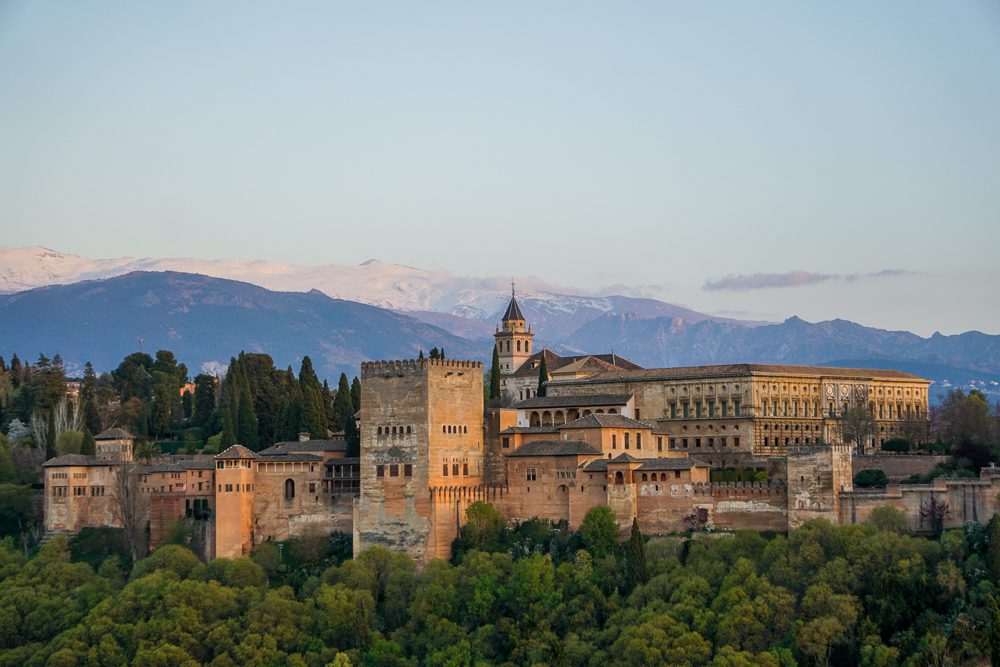
If you’re in Spain for a week and you spend your time in southern Spain, you can’t leave without visiting Granada. It’s home to the stunning and UNESCO-recognized Alhambra and was the last stronghold of the Moors before they were conquered by the Christians after ruling for 800 years!
Get your Alhambra tickets in advance for a morning visit and plan to spend a few hours at this Moorish palace-turned-citadel. What started as an earthen palace in the 9th century evolved into exquisite royal palaces and gardens beginning in the 1200s. It became home to King Muhammad Al-Ahmar.
This complex grew to include the Nasrid Palaces and, after the Christians took control, a church, monastery, and military barracks, as well. The result today is an incredible work of architectural fusion, art, and history that has been preserved for hundreds of years.
As you tour the palaces and visit the gardens, you get a sense of how the Alhambra was a mini-city all to itself. It’s also a site where you’ll want an audioguide or even a guided visit given its size and the vastness of the Alhambra’s history.
For the afternoon, divide your time exploring other areas of Granada. Head towards the Mirador de San Nicolas in the Albaicin neighborhood. From here, you can see the Alhambra in the distance with the Sierra Nevada Mountains in the background. In fact, it’s a popular spot to watch the sunset in Granada.
After some photos, stroll a bit in the Albaicin neighborhood, Granada’s oldest and also a protected UNESCO area. You’re also not far from Sacramonte, Granada’s gypsy neighborhood, but with limited time, I’d make the 15-minute walk from the Albaicin to Granada’s city center.
This area was where the Moorish medina once was before the Catholic Monarchs, Isabel and Ferdinand, had the Catedral de Granada built here atop a former Mosque. It’s also where they are laid to rest.
Afterward, walk through the narrow alleyways of Granada’s Alcaicería Market. It was once part of the larger souk that was here and still sells some handmade crafts, as well as more typical souvenirs.
Before ending your trip, be sure to indulge in Granada’s tapas scene! It’s perhaps the best in Spain, and sometimes even free with your drink. I can still taste the olives and fried eggplant!
Tonight, you can stay another night in Granada or take a high-speed evening train to Madrid in preparation for your flight tomorrow.
Day 7 – Depart
If you opted to stay in Granada for your last night, you could take the earliest high-speed train back to Madrid’s Atocha Station. The direct ride will take just under 4 hours before transferring to the airport train.
Alternatively, you could fly from Granada and connect through Madrid or Barcelona for your flight back home.
One Week in Spain Bottom Line
In Spain, you’re spoiled for choice! So when you’re planning a 1 week in Spain itinerary, it can be really hard to know how to divide your time.
Luckily, no matter how you plan to spend your 7 days in Spain, you’ll be rewarded with unforgettable history, sights, culture, natural beauty, and, of course, food! And in no time, you’ll be planning your next trip to Spain!
So, which Spain in one week itinerary do you have questions about?
Like this guide? Please share it using the social share buttons!


